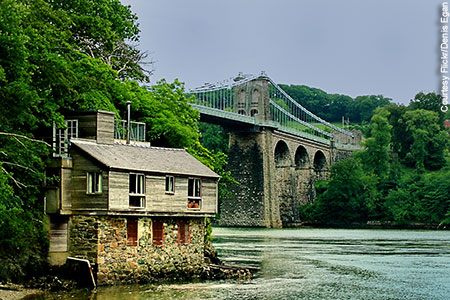Menai Suspension Bridge
53 13 13.1 N
4 09 48.1 W

The Menai Suspension Bridge was a major structure on the road connecting London with Holyhead and by sea to Ireland. The bridge had the world's longest span, which greatly advanced suspension bridge development.
"The Menai Bridge scheme excercised a fundamental influence on the construction and development of suspension bridges from 1818 for several decades. It established this type of bridge in its true role as the most economic means of providing the largest bridge spans for carriage traffic in the western world."
- Menai Bridge 1818-26 by R. A. Paxton
Built between 1819 and 1826, the Menai Bridge was the major structure on Britain's strategically important Holyhead Road connecting London with Holyhead and by sea to Ireland. Designed by Thomas Telford, the bridge's main span was 579 feet from tower to tower, the longest that had ever been attempted at this time. He used four sets wrought-iron eyebars to suspend the deck. These were made by William Hazledine at his Upton forge near Shrewsbury. Each bar being carefully tested in his Coleham shops before being pinned together and lifted into place. The roadway was only 24ft wide and, without stiffening trusses, soon proved highly unstable in the wind. The desk of the Menai Bridge was strengthened in 1840 by W. A. Provis; Sir Benjamin Baker replaced the timber deck with a steel deck in 1893. Despite these alterations, the gracefulness of Telford's original structure remains apparent.

